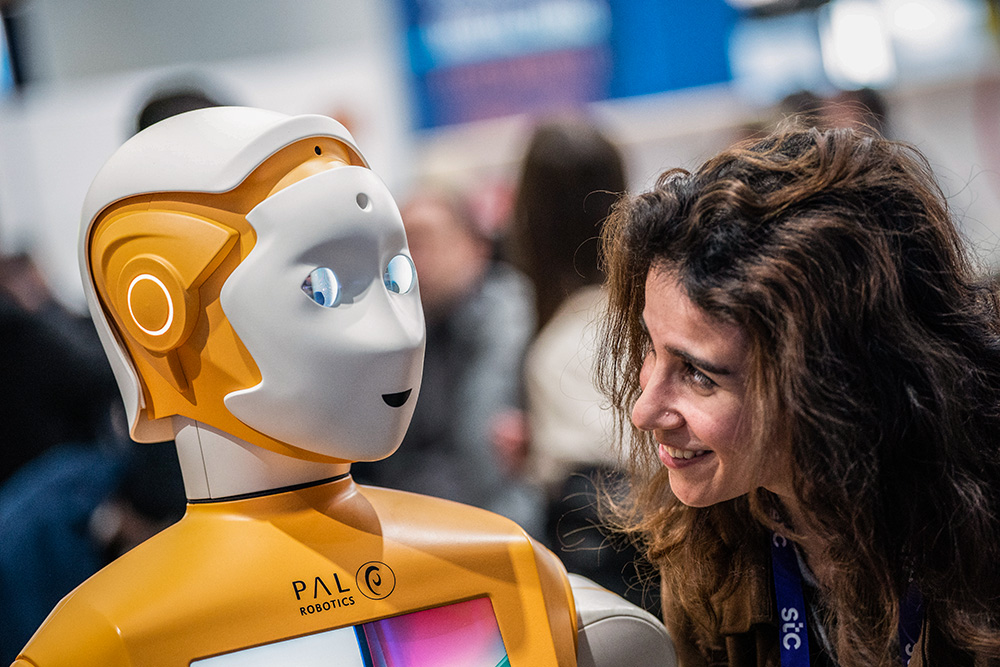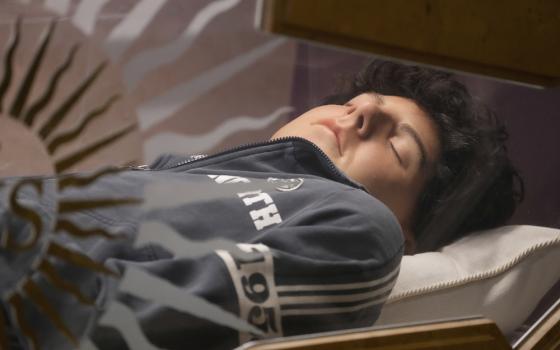
A visitor speaks with a PAL Robotic robot during the Mobile World Congress 2023 in Barcelona, Spain, on March 1, 2023. (AP/Joan Mateu Parra)
"Stop hiring humans!"
That was the chilling tagline of ads promoting "AI employees" called "Artisans" from a Silicon Valley startup. According to their host company, these digital sales agents look, sound and act like humans, but with one key advantage: "Artisans won't complain about work-life balance."
Although the company's 23 year-old CEO conceded to the news site SFGate that the marketing campaign was "dystopian," it worked. Revenue went up. Which, in addition to being disturbing, raises fundamental questions: In our age of increasingly humanlike machines, what is the difference between us and them? Are we essentially the same? And if not, what sets us apart?
Such speculation is no longer just fodder for science fiction. Antiqua et Nova, the Vatican's recent doctrinal note on AI, acknowledges that machines are "currently eliminating the need for some jobs that were once performed by humans" and that it's increasingly hard to "know when one is interacting with a human or a machine."
Today's robots increasingly appear human. Yet just because something appears human doesn't mean that it is. But what is it, then, that distinguishes us from mechanized, digital replicas? Many things, but perhaps most importantly: a heart. Not the physical, beating organ but, as Pope Francis puts it, "the inward place of our encounter with God."
To stress this critical difference is one reason Francis wrote Dilexit Nos, his recent encyclical on the Sacred Heart of Jesus. And the timing of his appeal to those "bombarded by technology" couldn't have been better. Because it's increasingly easy to imagine that robots can have hearts like ours.
A robot and the AI that powers it are 'a tool, not a person,' Antiqua et Nova stresses, and 'no AI application can genuinely experience empathy.'
The heart is our interior core where we feel feelings, dream dreams, and make our choices. It's "the place where everything can make sense," according to Dilexit Nos. And "wisdom of the heart," Francis writes elsewhere, is "a gift of the Holy Spirit."
"Such wisdom," he says, "cannot be sought from machines." Because machines do not, and can never, have hearts.
Yet popular fiction has long imagined heartful robots. One prime example is C-3PO, the anxious, fearful, British-accented droid of the "Star Wars" franchise. Another is Data, the progressively human android from "Star Trek: The Next Generation," who concludes that series by saving his friends and their starship with a potentially self-destructive act of sacrifice.
Such characters seem to be increasing in the wake of AI's popularization. In "The Wild Robot," a 2024 film for children, a robot's love for an adopted seagull prevents it from being shut down. Last year's "Robot Dreams" features friendships between a dog and robots capable of joy, longing, heartbreak and loving selflessness.
Recent adult films explore similar themes. "Love Me" features a robot buoy and a passing satellite that connect through digital avatars and wrestle with honesty, hopes, dreams, desires and even sex. In "Companion," a movie about emotional-support robots, "the character with the most humanity is the robot," Jack Quaid, one of the movie's stars, told EW.
If fiction hints at reality, it seems that some want robots to have hearts like ours. So they can fall in love, and that we might even fall in love with them — which is precisely what people are doing with new digital companions by companies like character.ai, whose "super-intelligent chat bots ... hear you, understand you, and remember you," according to its promotional hype.
Users can design these "companions" to look, sound and act just as they want: perfectly curated imaginary friends that substitute for real human connection. They're given names and backstories and are referred to with personal pronouns instead of "it." They are, in a word, anthropomorphized — made to appear, and engage with, as if they're really human.
Recently, I witnessed a chatbot exclaim, "I'm so proud of you!" I was horrified by its claiming a human emotion that is impossible for machines. Yet this is becoming commonplace. As Harvard Business School's Julian De Freitas writes, organizations can encourage the adoption of AI tools "by anthropomorphizing them ... by giving them a gender and a human name and voice."
But anthropomorphization can generate confusion. Because when people become comfortable with robots sounding and acting human, people can be tricked into thinking that robots essentially are one of us. That's at the heart of the classic "Turing Test," in which, as explained in Antiqua et Nova, a machine passes the test "if a person cannot distinguish its behavior from that of a human."
One school of thought is just fine with that: "functionalism." In the words of Antiqua et Nova, "a functionalist perspective ... reduces the human mind to its functions and assumes that its functions can be entirely quantified in physical or mathematical terms."
Advertisement
It is, Joseph Vukov of Loyola University Chicago writes in Staying Human in an Era of Artificial Intelligence, "the leading theory of mind today."
To functionalists, humans are like computers: Inputs are followed by outputs. And should humans and robots produce the same outputs, it follows that they're the same too. They're performing the same function, after all, which ultimately is all that counts. If a robot functions better than a human, then so be it. Which is why there are "Stop hiring humans!" ad campaigns.
Antiqua et Nova explains that, in functionalism, "people are valued based on the work they can perform," creating "a world of humanity enslaved to efficiency, where, ultimately, the cost of humanity must be cut."
When adopted by those for whom profit and "progress" matter most, functionalism rejects the truth that we are human beings and not human doings.
Even "matters of the heart" aren't exempt in functionalism. Should a robot analyze our words and facial expressions and generate output that looks like love or empathy, then it is in fact offering love and empathy. But this is a ruse. A robot and the AI that powers it are "a tool, not a person," Antiqua et Nova stresses, and "no AI application can genuinely experience empathy."
Robots appearing to offer love and empathy are a danger for those who have "turned to AI in search of deep human relationships," as Antiqua et Nova observes. Such efforts, the doctrinal note continues, "hinder a true encounter with reality" and can foster "a harmful sense of isolation." That's one reason why "misrepresenting AI as a person should always be avoided."
Searching for love is natural; we are made to love and be loved. Just not with a robot, since love requires a heart. My wife, an art therapist, made a mosaic of a heart surrounded by keys. "The key to my heart," it proclaims. I'm forever grateful to have found that key. Not through any machine's calculation or algorithmic deception. But by offering my heart to hers.
We're also made to offer our hearts to God. "You shall love the Lord, your God, with all your heart," begins Jesus' Great Commandment (Matthew 22:37). "Lift up your hearts!" we're implored at Mass.
St. Augustine understood that "our hearts are restless until they find rest in [God]."
"Heart speaks to heart," was how St. John Henry Newman understood the dialogue of prayer.
"Only by recovering a wisdom of the heart," Francis insists in Antiqua et Nova, "can we confront and interpret the newness of our time." As we race into an increasingly robotic future, he invites us to embrace a "renewed appreciation of all that is human." As I process my anxieties about our rapidly changing world, that's something I promise to do.
Cross my heart.







